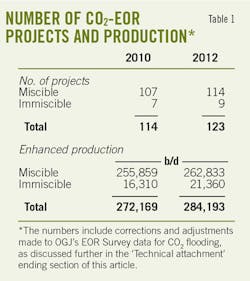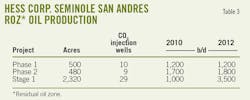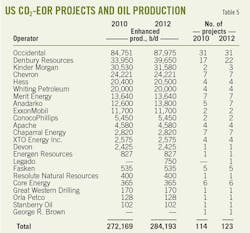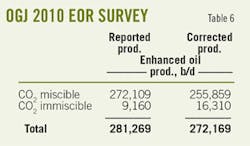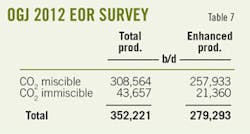QC updates carbon dioxide projects in OGJ's enhanced oil recovery survey
Vello Kuuskraa
Advanced Resources International Inc.
Arlington, Va.
Every 2 years, Oil & Gas Journal conducts a survey of carbon dioxide enhanced oil recovery activity, including providing detailed field by field reports of performance and oil production.1
The OGJ EOR Survey compiles EOR information voluntarily provided by industry and makes this information available to the public. The survey is the only publicly available compilation of EOR activity and thus provides a most valuable service and source of data.
As part of our analysis, we have made a small number of adjustments to the reported values for CO2-EOR oil production in the OGJ's EOR Survey for consistency and accuracy purposes, as further discussed in the Technical Attachment section of this article.
Because industry's participation in the OGJ survey is voluntary, some projects do not appear in the survey. In the 2012 survey these included KinderMorgan's CO2-EOR project at Katz oil field and Legado Resources's CO2-EOR project at Goldsmith in West Texas.
In addition, some of the information was not gathered due to operator changes such as the data for the CO2 floods at Greater Aneth and Means oil fields now operated by Resolute Energy and XTO Energy, respectively.
As a result the well status and oil production data have been the same for the past 4 years and may not be fully up to date.
Still, the information supplied is invaluable and these are small issues in comparison with the most valuable service and information compiled by the OGJ on CO2 EOR.
The purpose of the inaugural edition of the CO2-EOR newsletter is to take a more in-depth look at the information provided in OGJ's EOR Survey (augmented by other information available from operators) and to provide a set of selected key highlights and significant trends under way for CO2 EOR.
Key highlights and trends
The review of the EOR Survey data for 2012 and its comparison with the EOR survey data for 2010 provides four key highlights.
1. More projects, more production
The number of CO2-EOR projects has increased from 114 in 2010 to 123 in 2012, as industry is applying this EOR process to new fields and new geological settings (Fig. 1).
In addition, the adjusted EOR survey data show that oil production from CO2-EOR has increased from 272,169 b/d in 2010 to 284,193 b/d in 2012. About half of the increase in oil production is from expanded application of immiscible CO2-EOR, while the other half is from new CO2 miscible projects (Table 1).
In some respects, the 12,024 b/d growth in CO2-EOR is quite modest, given the strong recent oil prices. However, the initiation of CO2-EOR entails considerable lead times, and oil prices in 2009 and 2010 were considerably lower, at $60 to $76/bbl, respectively.
In addition, aggressive expansion of CO2-EOR needs to overcome numerous constraints including lack of sufficient, affordable CO2 supplies and time-consuming and costly assembly and unitization of oil field areas needed for optimum development of large-scale CO2 floods. And, when oil prices are robust, existing, mature well patterns within floods are left active for longer times and the efficiencies of CO2-EOR decline when measured in terms of the amount of CO2 needed to produce a barrel of oil. New projects are not implemented since the CO2 continues to be dedicated to existing projects. This is especially true in the Permian basin region of West Texas.
Fig. 2A provides a historical look at CO2-EOR production by region. The figure shows that much of the recent growth in production has been in the Gulf Coast and the Rockies, areas with increased availability of CO2 supplies. Fig. 2B provides a historical look at CO2-EOR production by technology—miscible vs. immiscible CO2 flooding. The figure shows that immiscible CO2, which was negligible 5 years ago, now is providing over 21,000 b/d of oil production.
Numerous new projects are normally needed in the oil industry to offset the sharp declines of the maturing projects. However, for the Permian basin CO2-EOR, improvements in technology and performance have kept oil production relatively flat (Table 2) in the increasingly mature major CO2 floods, such as at Wasson/Denver Unit (San Andres), Seminole (San Andres), and the SACROC (Canyon Reef).
2. New geological settings
Notable new CO2-EOR projects are under way in areas previously having little or no CO2-EOR activity, such as in the Rockies, East Texas, and the Gulf Coast.
• Montana. Denbury Resources announced the proposed initiation of miscible CO2-EOR in early 2013 in Bell Creek field in Montana. This is a significant project with 28 CO2 injection wells on 2,800 acres to recover 37° gravity oil from the Cretaceous Muddy sandstone at 4,500 ft.
Construction of the CO2 pipeline to Bell Creek is under way. In addition, Denbury has proposed to extend the Greencore CO2 pipeline farther north to undertake CO2 floods in the numerous oil fields on the Cedar Creek anticline.
• Wyoming. Anadarko Petroleum has added two new CO2 floods in the Southeast Unit of Salt Creek field in the Frontier/Wall Creek sandstone together involving 1,895 acres and 58 CO2 injection wells. Both CO2 floods are aimed at recovering light, 39° gravity oil, from relatively shallow depths, 1,750 ft and 2,200 ft, respectively.
In addition, Anadarko Petroleum plans to apply CO2-EOR to two deeper oil reservoirs (the Lakota and Sundance) in Salt Creek field and to expand the 25-acre pilot project in Sussex oil field (Tensleep) to 1,598 acres.
• East Texas. With the completion of the Green CO2 pipeline, Denbury Resources initiated two new CO2-EOR projects in East Texas at Oyster Bayou field in Chambers County and at West Hastings field in Brazoria County. The Oyster Bayou (Frio sandstone) miscible CO2 flood covers 3,900 acres and has 11 CO2 injection wells. It is in a deep (8,500 ft) reservoir with light 39° gravity oil. The West Hastings (Frio sandstone) immiscible CO2 flood is in a moderate depth (5,700 ft) formation with somewhat heavier (31° gravity) oil. Injection of CO2 and water is under way to increase reservoir pressure for conducting a miscible CO2 flood at West Hastings. Recently, Denbury announced an agreement to purchase Thompson field (Fort Bend County, Tex.) and undertake a CO2 flood after extending the Green CO2 Pipeline 18 miles west.
• Louisiana/Mississippi. By extending its CO2 pipeline network westward, Denbury Resources has added a second CO2-EOR project in Louisiana, the large miscible CO2 flood at Delhi (Paluxy/Tuscaloosa sandstone) covering 14,100 acres and 38 CO2 injection wells. The reservoir at Delhi is relatively shallow (3,500 ft) and holds light (42° gravity) oil. In addition, Denbury added the Heidelberg, East (Eutaw sandstone) oil reservoir to its expanding set of immiscible Mississippi CO2 floods. Heidelberg, East (Eutaw) is a moderate depth (4,700 ft) relatively heavy (23° gravity) oil reservoir. The CO2 flood covers 2,000 acres with 9 CO2 injection wells.
• Midcontinent. Chaparral Energy has been busy in the Oklahoma and Texas Panhandle region with a total now of five floods there to go with its two in central Oklahoma. Chaparral Energy is also working on an eighth flood at Burbank field in northeastern Oklahoma.
• Michigan. Although not large in production or CO2 volumes, the activity in the reef trend in northern Michigan remains strong. Core Energy has six floods and plans for a seventh starting in 2013.
3. Residual oil zone (ROZ) applications
The application of CO2-EOR to the ROZ (the residual oil zone in the "water leg" of an oil formation) is expanding and offering promise (OGJ, Mar. 13, 2006, p. 30).
• In OGJ's 2010 and 2012 EOR surveys, Hess Corp. reports increasing oil production from its three miscible CO2 floods in the ROZ interval of the Seminole Unit's San Andres dolomite reservoir (Table 3).
• Other CO2-EOR projects in the ROZ reported by industry but not recorded in the OGJ EOR survey are shown in Table 4).
4. Largest, fastest growing operators
Occidental has 31 miscible CO2-EOR projects in 2012, the same as in 2010, although its incremental oil production is up: 88,000 b/d in 2012 compared with 84,800 b/d in 2011.
Declining CO2-EOR oil production from the Denver Unit of giant Wasson field has been offset by increased oil production from Anton Irish, Cedar Lake, Cogdell, and Levelland fields.
Occidental plans to further expand its CO2-EOR activity this year in Slaughter (San Andres) and West Seminole (San Andres) oil fields in the Permian basin.
Denbury Resources has 22 CO2 projects (16 miscible and 6 immiscible) in 2012 compared with 17 (13 miscible and 4 immiscible) CO2 floods in 2010. The company's new CO2 floods are discussed earlier in this article. Denbury's incremental CO2-EOR oil production increased to 39,650 b/d in 2012 from 33,950 b/d in 2010.
Other significant CO2-EOR operators include Kinder-Morgan (31,580 b/d), Chevron (24,200 b/d), Hess (20,500 b/d), and Whiting (20,000 b/d).
Table 5 provides a comprehensive tabulation of enhanced CO2-EOR oil production and number of projects by operator for year 2010 and 2012.
Technical attachment
Discussion of updates to OGJ EOR surveys
The 2010 EOR survey contains a typographical error for enhanced oil production from Denbury Resources's Cranfield miscible CO2 flood. The correct value, according to the OGJ staff, should have been 1,050 b/d rather than 10,150 b/d.
In addition, two of Denbury's CO2 miscible projects at Tinsley and West Heidelberg (with a combined enhanced oil production of 7,150 b/d) should have been classified as immiscible, as corrected by Denbury in the 2012 EOR survey. Making these corrections, the value for year 2010 enhanced oil production from CO2-EOR would be as shown in Table 6.
In addition, in the 2012 EOR survey, OGJ incorrectly entered the revised US EOR production values for CO2-EOR for year 2010. According to the OGJ staff, the values for CO2-EOR for year 2010 should have been the corrected enhanced oil production values shown in Table 6.
In the 2012 EOR Survey, the data for oil production from CO2-EOR were for total oil production, from the oil field or unit under a CO2 flood, rather than for enhanced (or incremental) oil production due to the application of CO2-EOR. Keeping the classification of miscible and immiscible projects in the 2012 EOR survey the same as in the 2010 survey, the corrected data for 2012 are shown in Table 7.
Finally, the 2012 OGJ EOR survey excluded the active CO2 miscible project at Anadarko's Patrick Draw Monell Unit (with 3,100 b/d of enhanced oil production) which appeared in the 2010 EOR survey, and did not include two new miscible CO2-EOR projects (Kinder-Morgan's Katz with 1,050 b/d and Legado Resources' Goldsmith field Landreth Unit with 750 b/d.
The adjusted CO2 enhanced oil production values for 2012 include these three projects.
By incorporating this final set of corrections, the proper values for CO2-EOR enhanced oil production for year 2010 and 2012 would be as reported on Table 1 in this article.
Reference
1. Oil & Gas Journal, EOR Survey, Apr. 2, 2012. The information in the 2012 EOR Survey reflects CO2-EOR project status and oil production as of the end of 2011.
The author
More Oil & Gas Journal Current Issue Articles
More Oil & Gas Journal Archives Issue Articles
View Oil and Gas Articles on PennEnergy.com

